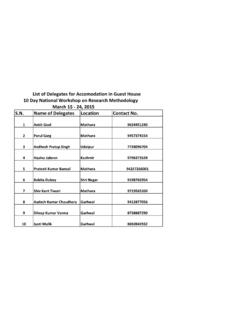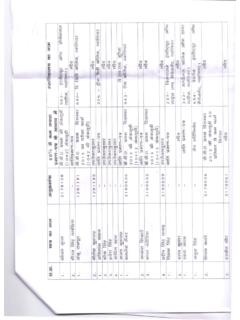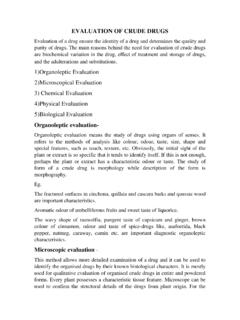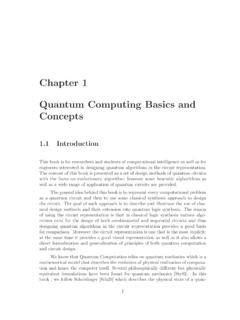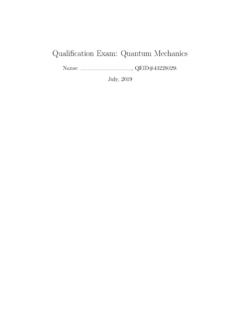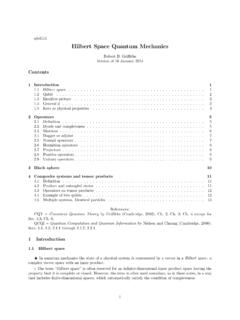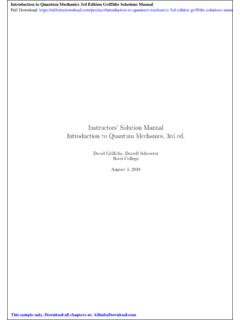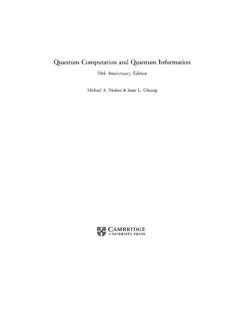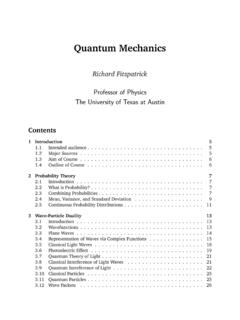Transcription of Angular Momentum in Quantum Mechanics - Jiwaji University
1 Angular Momentum in Quantum MechanicsAsaf Pe er1 April 19, 2018 This part of the course is based on Refs. [1] [3].1. IntroductionAngular Momentum plays a central role in both classical and Quantum Mechanics . Inclassical Mechanics , all isolated systems conserve Angular Momentum (as well as energy andlinear Momentum ); this fact reduces considerably the amount of work required in calculatingtrajectories of planets, rotation of rigid bodies, and , in Quantum Mechanics , Angular Momentum plays a central role in under-standing the structure of atoms, as well as other Quantum problems that involve other observable quantities, Angular Momentum is described in QM by an is in fact a vector operator, similar to Momentum operator.
2 However, as we willshortly see, contrary to the linear Momentum operator, the three components of the angularmomentum operator do not QM, there are several Angular Momentum operators: the total Angular Momentum (usually denoted by~J), the orbital Angular Momentum (usually denoted by~L) and theintrinsic, orspinangular Momentum (denoted by~S). This last one (spin) has no classicalanalogue. Confusingly, the term Angular Momentum can refer to either the total angularmomentum, or to the orbital Angular classical definition of the orbital Angular Momentum ,~L=~r ~pcan be carrieddirectly to QM by reinterpreting~rand~pas the operators associated with the position andthe linear spin operator,S, represents another type of Angular Momentum , associated with intrinsic rotation of a particle around an axis; Spin is anintrinsic property of a particle1 Physics Dep.
3 , University College Cork 2 (nearly all elementary particles have spin), that is unrelated to its spatial motion. Theexistence of spin Angular Momentum is inferred from experiments, such as the Stern-Gerlachexperiment, in which particles are observed to possess Angular Momentum that cannot beaccounted for by orbital Angular Momentum total Angular Momentum ,J, combines both the spin and orbital Angular momentumof a particle (or a system), namely~J=~L+~ Orbital Angular momentumConsider a particle of massm, Momentum ~pand position vector~r(with respect to afixed origin,~r= 0).
4 In classical Mechanics , the particle s orbital Angular Momentum is givenby a vector~L, defined by~L=~r ~p.(1)This vector points in a direction that is perpendicular to the plane containing~rand~p,and has a magnitudeL=rpsin , where is the angle between~rand~p. In Cartesiancoordinates, the components of~LareLx=ypz zpy;Ly=zpx xpz;Lz=xpy ypx.(2)The corresponding QM operators representingLx,LyandLzare obtained by replacingx,y,zandpx,pyandpzwith the corresponding QM operators, givingLx= i~ y z z y ;Ly= i~ z x x z ;Lz= i~ x y y x.
5 (3)In a more compact form, this can be written as avector operator,~L= i~(~r ~ ).(4)It is easy to verify that~Lis the commutation relations derived for~xand~p, the commutation relations betweenthe different components of~Lare readily derived. For example:[Lx,Ly] = [(ypz zpy),(zpx xpz)] = [ypz,zpx] + [zpy,xpz] [ypz,xpz] [zpy,zpx] (5) 3 Sinceyandpxcommute with each other and withzandpz, the first term reads[ypz,zpx] =ypzzpx zpxypz=ypx[pz,z] = i~ypx(6)Similarly, the second commutator gives[zpy,xpz] =zpyxpz xpzzpy=xpy[z,pz] =i~xpy(7)The third and forth commutators vanish; we thus find that[Lx,Ly] =i~(xpy ypx) =i~Lz.
6 (8)In a similar way, it is straightforward to show that[Ly,Lz] =i~Lx(9)and[Lz,Lx] =i~Ly(10)The three equations are equivalent to the vectorial commutation relation:~L ~L=i~~L.(11)Note that this can only be true for operators; since, for regular vectors, clearly~L ~L= fact that the operators representing the different components of the Angular momen-tum do not commute, implies that it is impossible to obtain definite values for all componentof the Angular Momentum when measured simultaneously. Thismeans that if the systemis in eigenstate of one component of the Angular Momentum , itwill in general not be aneigenstate of either of the other two define the operator representing the square of the magnitude of the orbital angularmomentum by~L2=L2x+L2y+L2z.
7 (12)It is easy to show that~L2does commute with each of the three components:Lx, example (using [L2x,Lx] = 0):[~L2,Lx] = [L2y+L2z,Lx] = [L2y,Lx] + [L2z,Lx]=Ly[Ly,Lx] + [Ly,Lx]Ly+Lz[Lz,Lx] + [Lz,Lx]Lz= i~(LyLz+LzLy) +i~(LzLy+LyLz) = 0.(13)Similarly,[~L2,Ly] = [~L2,Lz] = 0,(14) 4 which can be summarized as[~L2,~L] = 0.(15)Physically, this means that one can find simultaneous eigenfunctions of~L2and one of thecomponents of~L, implying that both the magnitude of the Angular Momentum and one ofits components can be precisely determined.
8 Once these are known, they fully specify theangular order to obtain the eigenvalues of~L2and one of the components of~L(typically,Lz),it is convenient to express the Angular Momentum operators in spherical polar coordinates:r, , , rather than the Cartesian coordinatesx,y,z. The spherical coordinates are relatedto the Cartesian ones viax=rsin cos ;y=rsin sin ;z=rcos .(16)After some algebra, one gets:Lx= i~ sin cot cos Ly= i~ cos cot sin Lz= i~ ;~L2= ~2h1sin sin +1sin2 2 2i.(17)We thus find that the operatorsLx,Ly,Lzand~L2depend on and only, that is theyare independent on the radial coordinate~r.
9 All these operators therefore commute with anyfunction ofr,[Lx,f(r)] = [Ly,f(r)] = [Lz,f(r)] = [L2,f(r)] = 0.(18)Also, obviously, if a wavefunction dependsonlyonr(but not on , ) it can be simultaneouslyan eigenfunction ofLx,Ly,LzandL2. In all cases, the corresponding eigenvalue will be0. (This is the only exception to the rule that that eigenvalues of one component ( ,Lx)cannot be simultaneously eigenfunctions of the two other components ofL).3. Eigenvalues and eigenfunctions of L2andLzLet us find now the common eigenfunctions toL2andLz, for a single particle.
10 Thechoice ofLz(rather than, ,Lx) is motivated by the simpler expression (see Equation 17). 5 Eigenvalues ofLzSince, in spherical coordinatesLzdepends only on , we can denote its eigenvalue bym~and the corresponding eigenfunctions by m( ). We thus have:Lz m( ) =m~ m( ),(19)namely i m( ) =m m( ).(20)The solutions to this equation are m( ) =1 2 eim .(21)This is satisfied for any value ofm; however, physically we require the wave function to besingle valued(alternatively:continuous), namely m(2 ) = m(0), from which we findei2 m= 1.


